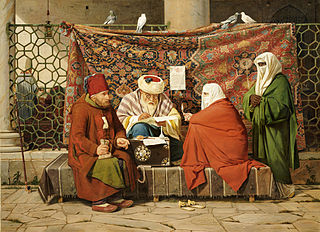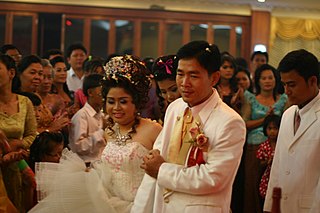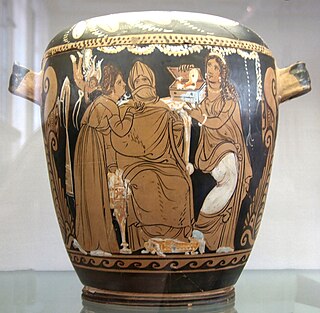Related Research Articles

Marriage, also called matrimony or wedlock, is a culturally and often legally recognized union between people called spouses. It establishes rights and obligations between them, as well as between them and their children, and between them and their in-laws. It is nearly a cultural universal, but the definition of marriage varies between cultures and religions, and over time. Typically, it is an institution in which interpersonal relationships, usually sexual, are acknowledged or sanctioned. In some cultures, marriage is recommended or considered to be compulsory before pursuing any sexual activity. A marriage ceremony is called a wedding.

A wife is a woman in a marital relationship. A woman who has separated from her partner continues to be a wife until their marriage is legally dissolved with a divorce judgment. On the death of her partner, a wife is referred to as a widow. The rights and obligations of a wife to her partner and her status in the community and law vary between cultures and have varied over time.
A mail-order bride is a woman who lists herself in catalogs and is selected by a man for marriage. In the twentieth century, the trend was primarily towards women living in developing countries seeking men in more developed nations. The majority of the women making use of these services from the 1970s to the present are from East Asia, Southeast Asia, Eastern Europe, and Latin America. Since the 1990s, large numbers of eastern European women have advertised themselves in such a way, primarily from Russia, Belarus, Ukraine, Georgia and Moldova. Men who list themselves in such publications are referred to as "mail-order husbands", although this is much less common.
A dowry is a payment, such as property or money, paid by the bride's family to the groom or his family at the time of marriage. Dowry contrasts with the related concepts of bride price and dower. While bride price or bride service is a payment by the groom, or his family, to the bride, or her family, dowry is the wealth transferred from the bride, or her family, to the groom, or his family. Similarly, dower is the property settled on the bride herself, by the groom at the time of marriage, and which remains under her ownership and control.

In Islam, nikah is a contract between two people. Both the groom and the bride are to consent to the marriage of their own free wills. A formal, binding contract – verbal or on paper – is considered integral to a religiously valid Islamic marriage, and outlines the rights and responsibilities of the groom and bride. Divorce in Islam can take a variety of forms, some executed by a husband personally and some executed by a religious court on behalf of a plaintiff wife who is successful in her legal divorce petition for valid cause. Islamic marital jurisprudence allows Muslim men to be married to multiple women.
The Algerian Family Code, enacted on June 9, 1984, specifies the laws relating to familial relations in Algeria. It includes strong elements of Islamic law which have brought it praise from Islamists and condemnation from secularists and feminists.

Traditional Chinese marriage is a ceremonial ritual within Chinese societies that involves not only a union between spouses but also a union between the two families of a man and a woman, sometimes established by pre-arrangement between families. Marriage and family are inextricably linked, which involves the interests of both families. Within Chinese culture, romantic love and monogamy were the norm for most citizens. Around the end of primitive society, traditional Chinese marriage rituals were formed, with deer skin betrothal in the Fuxi era, the appearance of the "meeting hall" during the Xia and Shang dynasties, and then in the Zhou dynasty, a complete set of marriage etiquette gradually formed. The richness of this series of rituals proves the importance the ancients attached to marriage. In addition to the unique nature of the "three letters and six rituals", monogamy, remarriage and divorce in traditional Chinese marriage culture are also distinctive.

Marriage in ancient Rome was a fundamental institution of society and was used by Romans primarily as a tool for interfamilial alliances. Roman marriage was a monogamous institution: Roman citizens could have only one spouse at a time but allowed divorce and remarriage. This form of monogamy in Greco-Roman civilization may have arisen from the relative egalitarianism of democratic and republican city-states. Early Christianity embraced this ideal of monogamous marriage, and perpetuated it as an essential element in many later Western cultures.

A husband is a man in a marital relationship, who may also be referred to as a spouse. The rights and obligations of a husband regarding his spouse and others, and his status in the community and in law, vary between societies and cultures, and have varied over time.

Marriage in Korea mirrors many of the practices and expectations of marriages in other societies. Modern practices are a combination of millennia-old traditions and global influences.
The War Brides Act was enacted to allow alien spouses, natural children, and adopted children of members of the United States Armed Forces, "if admissible," to enter the U.S. as non-quota immigrants after World War II. More than 100,000 entered the United States under this Act and its extensions and amendments until it expired in December 1948. The War Brides Act was a part of new approach to immigration law that focused on family reunification over racial exclusion. There were still racial limits that existed particularly against Asian populations, and Chinese spouses were the only Asian nationality that qualified to be brought to the United States under the act. Additionally, the War Brides Act was well supported and easily passed because family members of servicemen were the recipients, but there were concerns over marital fraud which caused some tensions.
The type, functions, and characteristics of marriage vary from culture to culture, and can change over time. In general there are two types: civil marriage and religious marriage, and typically marriages employ a combination of both. Marriages between people of differing religions are called interfaith marriages, while marital conversion, a more controversial concept than interfaith marriage, refers to the religious conversion of one partner to the other's religion for sake of satisfying a religious requirement.

Courtship, marriage, and divorce in Cambodia are important aspects of family life. Customs vary as between rural and urban areas, with many city dwellers being influenced by western ideas. The choice of a spouse is usually undertaken by the families of young men and women, sometimes with the help of a matchmaker. A man usually marries between the ages of nineteen and twenty-five and a woman between sixteen and twenty-two.
The matrimonial law of Singapore categorizes marriages contracted in Singapore into two categories: civil marriages and Muslim marriages. The Registry of Marriage (ROM) administers civil marriages in accordance to the Women's Charter, while the Registry of Muslim Marriages (ROMM) administers Muslim marriages in accordance to the Administration of Muslim Law Act (AMLA). All marriages performed in Singapore must be registered with the relevant registry in order to be legally valid.
Vietnamese migrant brides in Taiwan represent marriages between Taiwanese men and Vietnamese brides who are mostly from poor, rural areas of Vietnam, such as those along the Mekong Delta. As of 2006, out of Taiwan’s immigrant population of approximately 428,240 people, 18% were females who had relocated to the country through marriage. Out of this population, about 85% originated from the Southeast Asian countries of Vietnam, Indonesia, Thailand, and Philippines, with the majority hailing from Vietnam. It is estimated that between the years of 1995 and 2003, the number of Vietnamese women married to Taiwanese men increased from 1,476 to more than 60,000 individuals, making the Vietnamese the largest non-Chinese immigrant group living in the island. This event has been seen locally and abroad as something that can potentially evolve into a concerning societal and humanitarian issue. This issue is not just localised in Taiwan but also in Southern China provinces as well as Hong Kong and Macau. In every case, these practices are illegal and are classified under human trafficking.
Arranged marriage is a type of marital union where the bride and groom are primarily selected by individuals other than the couple themselves, particularly by family members such as the parents. In some cultures, a professional matchmaker may be used to find a spouse for a young person.

In South Korea, immigration policy is handled by the immigration services of the Ministry of Justice, Ministry of Labor, Ministry of Health and Welfare and the Ministry of Foreign Affairs and Trade. The Nationality Act, Immigration Control Act, Multicultural Families Support Act, and the Framework Act on Treatment of Foreigners are the foundations of immigration policy in Korea. The Korean government initiated a discussion in 2003 on establishing an independent immigration office to accommodate fast-growing immigrant and to prepare inclusive and rational immigration policies; however, there has been little progress. The Foreigner Policy Committee, headed by the Prime Minister, coordinates foreigner-related policies which were handled by many ministries. However, its role is limited because of a shortage of resources and manpower. The establishment of an Immigration Office is expected to solve these problems by concentrating all related resources and manpower under one umbrella.

Bride price, bride-dowry, bride-wealth, or bride token, is money, property, or other form of wealth paid by a groom or his family to the woman or the family of the woman he will be married to or is just about to marry. Bride dowry is equivalent to dowry paid to the groom in some cultures, or used by the bride to help establish the new household, and dower, which is property settled on the bride herself by the groom at the time of marriage. Some cultures may practice both simultaneously. Many cultures practiced bride dowry prior to existing records.

Marriage in ancient Greece had less of a basis in personal relationships and more in social responsibility. The goal and focus of all marriages was intended to be reproduction, making marriage an issue of public interest. Marriages were usually arranged by the parents; on occasion professional matchmakers were used. Each city was politically independent and each had its own laws concerning marriage. For the marriage to be legal, the woman's father or guardian gave permission to a suitable man who could afford to marry. Daughters were usually married to uncles or cousins. Wintertime marriages were popular due to the significance of that time to Hera, the goddess of marriage. The couple participated in a ceremony which included rituals such as veil removal, but it was the couple living together that made the marriage legal. Marriage was understood to be the official transition from childhood into adulthood for women.
Transnational marriages in the Sino-Vietnamese border areas of China have rapidly increased since the re-opening of the border in the 1990s. In the Sino-Vietnamese border areas, the building of intimation relationship is usually between a Chinese man and a Vietnamese woman. Historically, transnational marriages were common due to unclear state and ethnic boundaries in border areas. In the modern era, the formation of transnational marriages here is multifold. Thereinto, imbalanced economic development in border areas of China and Vietnam is one of the most significant incentives.
References
- ↑ Sugimoto, Yoshio (2010). An Introduction to Japanese Society. Cambridge University Press. p. 69. ISBN 9781139489478.
- 1 2 3 4 5 6 7 8 9 "Yodo Journal; Where Want Ads Are Bait and Weddings Forced". The New York Times . 14 April 1991.
- 1 2 Staff writer (July 1997). "Japan's new immigration law". Migration News. 4 (6).
- 1 2 3 4 5 6 7 8 Gorman, Scott (13 January 2009). "The marriage broker". leit.ru. Scott Gorman via WordPress. Archived from the original on 26 June 2009. Retrieved 13 January 2009.[ self-published source ]
- 1 2 Staff writer (30 May 2007). "19 prefectures to see 20% population drops by '35". The Japan Times Online . Tokyo: Kyodo News.
- 1 2 3 4 Kosai, Yutaka; Saito, Jun; Yashiro, Naohiro (May 1998). "Declining population and sustained economic growth: can they coexist?". The American Economic Review. 88 (2): 412–416. JSTOR 116958.
- ↑ Hendry, Joy (2003). Understanding Japanese society (3rd ed.). London New York: RoutledgeCurzon. ISBN 9780415263832.
- ↑ Vogel, Ezra F. (1971). Japan's new middle class; the salary man and his family in a Tokyo suburb (2nd ed.). Berkeley: University of California Press. ISBN 9780520021006.
- ↑ Retherford, Robert D.; Ogawa, Naohiro; Matsukura, Rikiya (March 2001). "Late marriage and less marriage in Japan". Population and Development Review . 27 (1): 65–102. doi:10.1111/j.1728-4457.2001.00065.x.
- ↑ Burgess, Chris (September 2004). "(Re)constructing identities: international marriage migrants as potential agents of social change in a globalising Japan". Asian Studies Review. 28 (3): 223–242. doi:10.1080/1035782042000291079. S2CID 145265023.
- ↑ Staff writer (30 December 2005). "Carrying on with fewer people". The Japan Times Online . Tokyo: Kyodo News.
- ↑ Faiola, Anthony (3 March 2005). "A baby bust empties out Japan's schools". The Washington Post . Nash Holdings LLC.
- 1 2 Knight, John (April 1995). "Municipal matchmaking in rural Japan". Anthropology Today . 11 (2): 9–17. doi:10.2307/2783202. JSTOR 2783202.
- 1 2 3 4 5 6 Nakamatsu, Tomoko (September–October 2005). "Faces of "Asian brides": Gender, race, and class in the representations of immigrant women in Japan". Women's Studies International Forum . 28 (5): 405–417. doi:10.1016/j.wsif.2005.05.003.
- ↑ Nagatomo, D.H. (2016). Identity, Gender and Teaching English in Japan. New Perspectives on Language and Education. Channel View Publications. p. 85. ISBN 978-1-78309-522-3 . Retrieved 2 September 2023.
- ↑ Oishi, Nana (2005). Women in Motion: Globalization, State Policies, and Labor Migration in Asia. Stanford University Press. p. 36. ISBN 9780804746380.
- 1 2 3 4 5 Ryall, Julian (28 September 2008). "In Japan, divorce shuts foreigners off from children". South China Morning Post . SCMP Group. p. 12. Retrieved 8 August 2009.
- ↑ Statistics Bureau (2012), "Chapter 2 Population", in Statistics Bureau, ed. (2012). The statistical handbook of Japan: 2012. Tokyo, Japan: Nihontōkeikyōkai. ISBN 9784822337209.
- ↑ Barnett, Larry D. (February 1963). "Research on international and interracial marriages". Marriage and Family Living. 25 (1): 105–107. doi:10.2307/349019. JSTOR 349019.
- ↑ "Spectrum | Sundayobserver.lk - Sri Lanka".
- ↑ "Oshin joins with a Sinhala film 'Kandak Sema'".